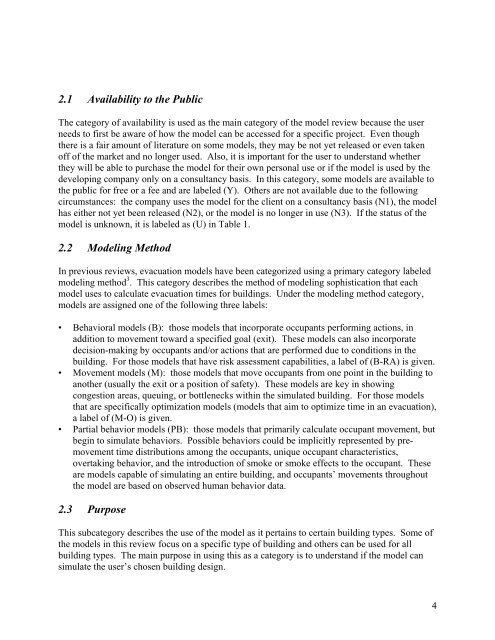A Review of Building Evacuation Models - NIST Virtual Library
A Review of Building Evacuation Models - NIST Virtual Library
A Review of Building Evacuation Models - NIST Virtual Library
Create successful ePaper yourself
Turn your PDF publications into a flip-book with our unique Google optimized e-Paper software.
2.1 Availability to the Public<br />
The category <strong>of</strong> availability is used as the main category <strong>of</strong> the model review because the user<br />
needs to first be aware <strong>of</strong> how the model can be accessed for a specific project. Even though<br />
there is a fair amount <strong>of</strong> literature on some models, they may be not yet released or even taken<br />
<strong>of</strong>f <strong>of</strong> the market and no longer used. Also, it is important for the user to understand whether<br />
they will be able to purchase the model for their own personal use or if the model is used by the<br />
developing company only on a consultancy basis. In this category, some models are available to<br />
the public for free or a fee and are labeled (Y). Others are not available due to the following<br />
circumstances: the company uses the model for the client on a consultancy basis (N1), the model<br />
has either not yet been released (N2), or the model is no longer in use (N3). If the status <strong>of</strong> the<br />
model is unknown, it is labeled as (U) in Table 1.<br />
2.2 Modeling Method<br />
In previous reviews, evacuation models have been categorized using a primary category labeled<br />
modeling method 3 . This category describes the method <strong>of</strong> modeling sophistication that each<br />
model uses to calculate evacuation times for buildings. Under the modeling method category,<br />
models are assigned one <strong>of</strong> the following three labels:<br />
• Behavioral models (B): those models that incorporate occupants performing actions, in<br />
addition to movement toward a specified goal (exit). These models can also incorporate<br />
decision-making by occupants and/or actions that are performed due to conditions in the<br />
building. For those models that have risk assessment capabilities, a label <strong>of</strong> (B-RA) is given.<br />
• Movement models (M): those models that move occupants from one point in the building to<br />
another (usually the exit or a position <strong>of</strong> safety). These models are key in showing<br />
congestion areas, queuing, or bottlenecks within the simulated building. For those models<br />
that are specifically optimization models (models that aim to optimize time in an evacuation),<br />
a label <strong>of</strong> (M-O) is given.<br />
• Partial behavior models (PB): those models that primarily calculate occupant movement, but<br />
begin to simulate behaviors. Possible behaviors could be implicitly represented by premovement<br />
time distributions among the occupants, unique occupant characteristics,<br />
overtaking behavior, and the introduction <strong>of</strong> smoke or smoke effects to the occupant. These<br />
are models capable <strong>of</strong> simulating an entire building, and occupants’ movements throughout<br />
the model are based on observed human behavior data.<br />
2.3 Purpose<br />
This subcategory describes the use <strong>of</strong> the model as it pertains to certain building types. Some <strong>of</strong><br />
the models in this review focus on a specific type <strong>of</strong> building and others can be used for all<br />
building types. The main purpose in using this as a category is to understand if the model can<br />
simulate the user’s chosen building design.<br />
4
















